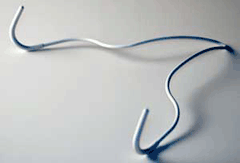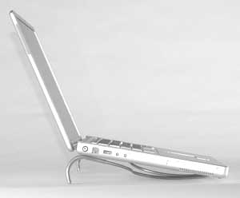Review: iRac
Sometime during the last six months, I became the Unofficial ATPM Laptop Stand Review GuyTM. The latest offering in this category, called the iRac, is the intriguing product of an Ohio University professor’s imagination, combined with a coat hanger and some spare time. Essentially a two-foot piece of very heavy steel wire, the iRac’s claims to fame are its low cost, light weight, and unique design.

The iRac comes in two colors: white, to match your iMac or iBook; and stainless steel, which complements recent PowerBooks very nicely, and wouldn’t look entirely out of place with an iMac, either. Both colors have rubber “socks” on the tips of the wire for added grip and to protect the surface of the laptop or keyboard. Early versions of the white iRac (including the review model) lacked the rubber sleeve on the apex, but all new iRacs are shipping with the rubber sleeve for additional scratch and skid protection.

In terms of functionality, the iRac is nearly perfect. It raises a 15" PowerBook G4 about two inches at the back (roughly the same as a PodiumPad with two risers installed) and holds it fairly securely in place. I never worried that the PowerBook might slide off the stand, although the tripod layout of the stand makes it somewhat less stable than a PodiumPad or iLap. The width and depth of the iRac can be adjusted by hand to fit larger laptops, although it may be on the large side for a 12" PowerBook or iBook, or a similarly sized Wintel laptop. The height, on the other hand, is essentially fixed. It could probably be bent to a higher incline with the use of appropriate tools, but the standard height should be about right for most applications. For use as a keyboard rack on an iMac G4, it’s unlikely that any adjustments will need to be made at all unless your keyboard is very oddly shaped.

A word about the iRac’s use with an iMac: because I’m primarily a laptop user, this is written primarily as a review of those capabilities. I can envision the iRac being quite nice for getting a keyboard out of the way on an otherwise-overcrowded desk when you want to do some non-computer work on the desk. College dorm desks are always too small, and the iRac could easily provide the extra space a student needs to get homework done at her desk. Best of all, it won’t break a student budget. Watch out for the Eject button, though—ejecting the optical drive with the keyboard hanging in the iRac will give your optical drive fits!
Perhaps the biggest drawback to the iRac’s unique—and, to my eye, very refreshing—design is that it proves completely useless on anything other than a flat, firm surface. A PodiumPad can work on a lap or a pillow in a pinch, but the iRac’s design places pressure points precisely where you don’t want them on your lower body, and it sinks into soft surfaces easily, essentially negating the elevation and improved airflow it provides on a desk.
Since no one has yet made the perfect laptop stand that combines portability with use-anywhere convenience, perhaps owning two stands is the answer to the laptop warrior’s dilemma. The iRac’s low price makes it an attractive option for a travel stand to complement a more expensive local-use stand such as an iLap (which is too big to travel well) or an iCurve (which doesn’t travel at all), and the combination is more effective than any single laptop stand could be.

Reader Comments (1)
Also, for travelling, I would like a stand that can be used anywhere, like an airline seat tray, one's lap in the waiting area at an airport, etc. I'd reverse your recommendations and suggest that the iRac is better for local use, not for travel.
Add A Comment